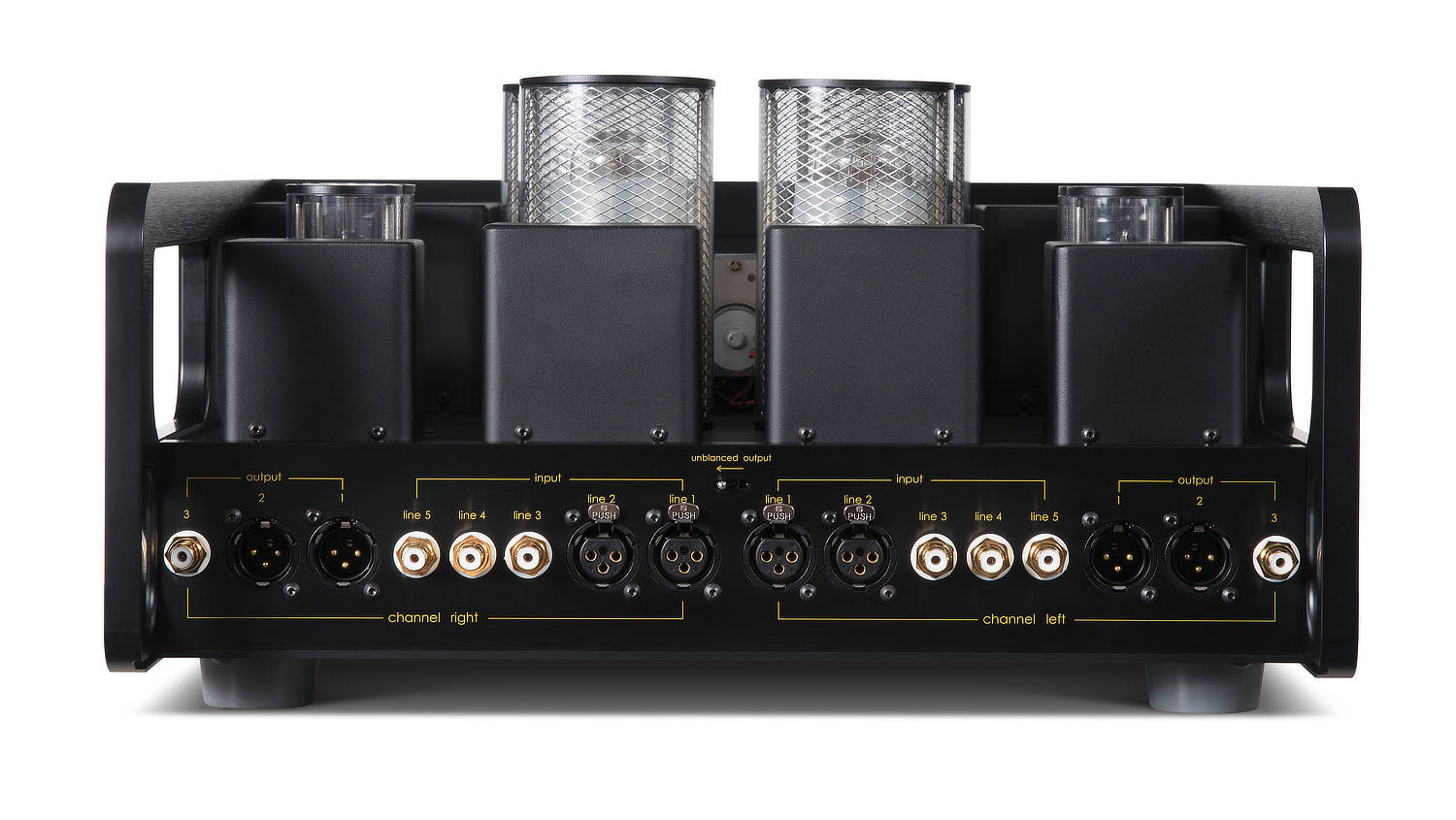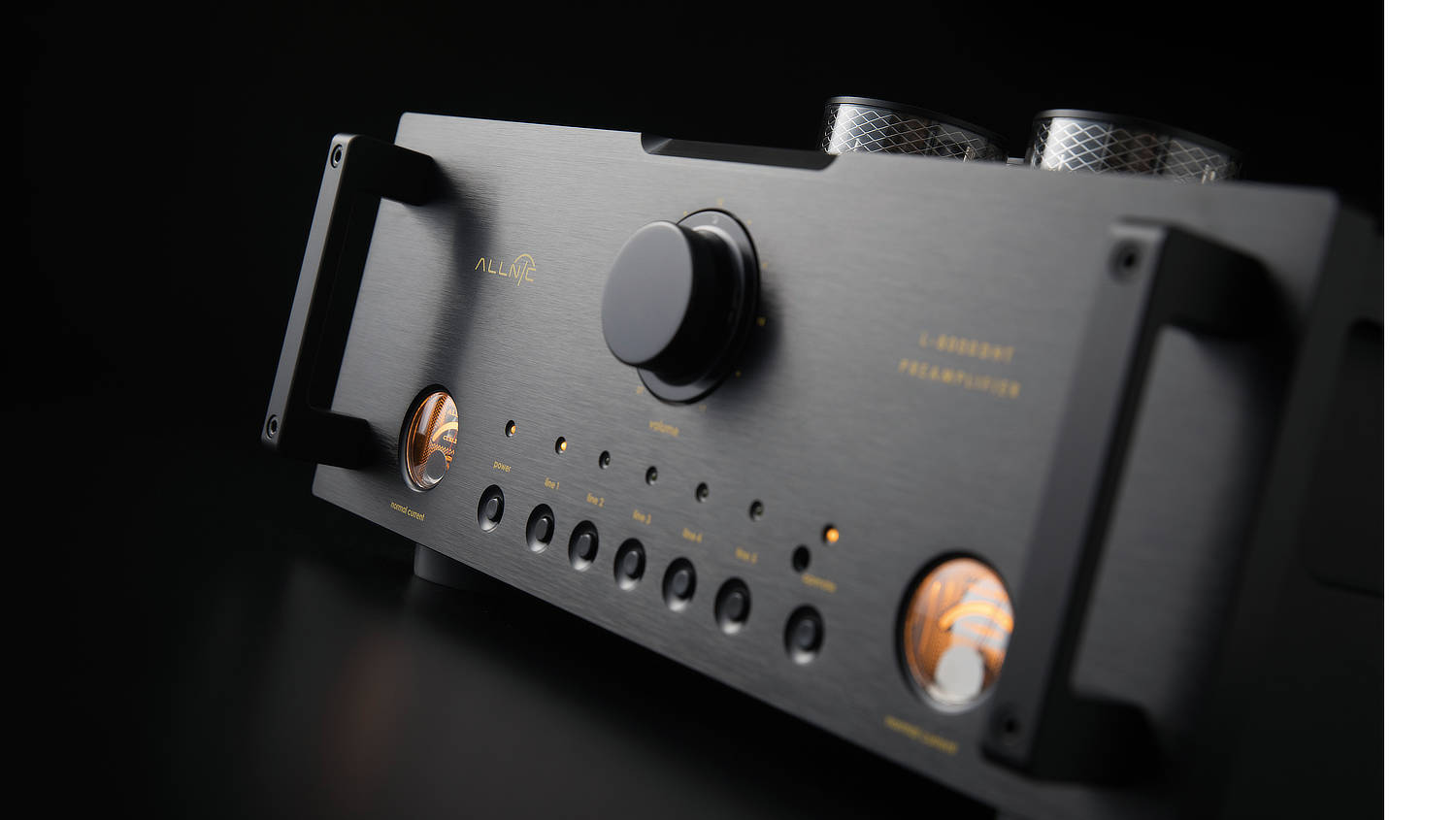L-8000 DHT Preamplifier




The L-8000 DHT preamplifier is the improved successor to the L-5000 DHT
The Allnic L-8000 DHT preamplifier is the improved successor to the L-5000 DHT, which was the world’s first commercially produced, pure DHT preamplifier.
- All signal circuits with DHT (Direct Heated Triode)
- Line output transformer coupling
- No negative feedback design
- Advanced tube technology voltage regulation
- 61-step Silver Contact Constant Impedance attenuator
L-8000 DHT Preamplifier Details
In the early years of the last century, the directly heated triode was invented independently, and almost simultaneously, in the USA and Austria. This simple device, an anode, cathode and a grid in a vacuum contained in a glass bottle, transformed the world. With all the applications in which it has been employed, and with all the changes in electronic design for audio reproduction that have occurred since its invention, it is remarkable that over one hundred years later, the very first triode, the simplest vacuum tube audio signal amplifier, despite the imperfections ascribed to it, remains a favourite audio amplification device of many devoted music lovers worldwide.
Debate, on both subjective and empirical bases, about the quality of the directly heated triode’s sound reproduction potential continues even today. One of the interesting aspects of these debates is the degree to which they ignore analysis of common, fundamental assumptions based on decades of circuit and mechanical design experimentation and compromise, about the use of these devices. Indeed, because of the difficulties in application of directly heated triodes in audio circuits, many issues arising out of circuit design problems related to them have evolved into assumptions about the audio characteristics of the valves themselves.
Allnic’s Mr. Kang Su Park has spent a lifetime studying and designing circuits and transformers for application of direct heated triodes for audio reproduction. By questioning basic assumptions about the valves and re-examining the original and many historical variations of circuit designs for them, and experimenting constantly in a framework of rigorous application of theory, Mr. Park’s work has resulted in some remarkable audio power amplification devices.
With the 300B, for example, his creations produce significantly more power than is expected (without shortening valve life because the power increase is not achieved by increased bias), in conjunction with exceptionally low distortion and wide bandwidth.
Now, Mr. Park has successfully combined elements of what he has learned and invented over decades to the development and production of a pure, direct heated triode (DHT) based preamplifier. The main breakthrough, which came after several years of work applying all he knows, was the design of a circuit, valve and transformer combination the measured results of which astounded him. The purity of its square wave reproduction – as perfect as anything he had ever seen from a DHT valve amplification circuit – had him questioning what he was seeing!
Of course, he tested and re-tested, replicated and recorded these results many times before assuring himself that there was no mistake. With such an unprecedented outcome for the circuit design, Mr. Park could not be satisfied merely with placing a DHT stage after one or two prior stages of amplification using indirectly heated triodes. This approach is used in a number of commercially available preamplifiers using DHTs, but it is a compromise. It does not result in PURE DHT amplification; it necessarily introduces the characteristics of indirectly heated triode sound into the circuit, so the output DHTs are only amplifying a signal already affected by the indirectly heated triodes in the prior stage or stages.
Mr. Park, though, created a preamplifier that uses DHTs at each amplification stage. In his design, the output stage DHTs are not merely amplifying the signal from previous, indirectly heated triode stages. The L-5000 DHT preamplifier, predecessor to the L-8000 DHT, was pure DHT – from input to output.
Of course, Mr. Park is not the only builder who has accomplished this, but to our knowledge no other pure DHT preamplifiers have been commercially available. There are serious and significant reasons why such preamplifiers could not be acceptable in the marketplace. First among them has been the enormous problem of microphonics. One of the many special elements of Mr. Park’s design is reduction of microphonic influence on the DHT’s. Where others have sometimes accepted the effects of this problem because even with it they prefer the incredible realism of the pure DHT approach, Mr.Park has succeeded in creating a circuit and mechanical design that reduces the DHTs’ susceptibility to microphonic influence to insignificance. Like the Allnic L-7000, which is an indirectly heated triode preamplifier, the L-8000 has a noise floor that is effectively absent.
The Allnic L-8000 DHT preamplifier is the improved successor to the L-5000 DHT, which was THE WORLD’S FIRST COMMERCIALLY PRODUCED, PURE DHT PREAMPLIFIER.
Allnic Audio’s newly developed 61 step constant impedance bridged type attenuator, a world’s first, is installed inside the L-8000 DHT, which contributes to the L-8000 DHT’s outstanding dimensional sound. It does so by ensuring that the attenuator’s impedance is absolutely constant across all frequencies. This is in addition to the zero channel imbalance, a standard feature of Allnic’s in-house produced, motorized attenuators.
The L-8000 DHT has the following features:
- Line output transformer coupling – The L-8000 DHT is “transformer coupled”, using transformers that have been upgraded from those in the L-5000 DHT. In tube amp circuitry, there are two coupling methods; one is capacitor coupling and the other is transformer coupling. Capacitor coupling is the traditional, low cost method. It is somewhat stable but transfers only voltage, not wattage (i.e., not real energy). With transformer coupling, about 90% of real wattage is transferred (there is still a transformer loss of about 10% of wattage – voltage is not affected).
- Transformer coupling is superior to capacitor coupling. However, all the advantages of transformer coupling depend on the quality of the transformer and on the choice of tubes. Allnic Audio manufactures its own transformers and uses what it views to be the best core material, Permalloy. Allnic Audio’s unprecedented, wide (16Hz ~ 75kHz, -3db), low distortional, and ultra-flexible (up to 50kHz square wave response) output transformer helps Allnic Audio to realize the ideal transformer coupled preamplifier. Of course, gain tubes are also carefully selected for three critical factors for function with the Permalloy output transformers: high gm, low internal resistance and high mu.
Constant and low output impedance – One of the benefits of transformer coupling is that it facilitates constant low output impedance. Low output impedance is critical to the design of a good preamplifier. The L-8000 DHT has a 120 ohm (120Ω) constant output impedance at all frequencies. In capacitor coupling (C-R coupling), a “cathode follower circuit” is usually used to lower output impedance. Unfortunately, this method of lowering output impedance is accompanied by high distortion and has an “L” shaped output impedance curve.
- No negative feedback design
- Advanced tube technology voltage regulation – For quieter and more dynamic operation, the L-8000 DHT has an ultra-high speed automatic voltage regulation circuit, utilizing vacuum tubes. This also protects the amplifying tubes from change in the AC line supply and copes with any abrupt, internal current demand.
- New vacuum tube damping technology – Allnic Audio’s patented “Absorb GEL tube damper” technology prevents harmful vibrations from reaching the signal / gain tubes and, therefore, prevents microphonic noise propagation in the tubes. The Allnic Audio Absorb Gel damper technology effectively solves a problem that plagues most tube, and especially DHT, amplification systems. Provided other tube components do not introduce microphonic noise into your system, with the Absorb Gel damping system, you will enjoy a degree of transparent sound that will surprise and please you.
- Precision attenuator volume control – The L-8000 does not employ a digital IC volume control or a low-cost carbon film volume control with a motor. The L-8000 uses the WORLD’S FIRST 61 step, constant impedance, “bridged” type attenuator. Allnic’s new attenuator is now the most sophisticated on the market, and we believe, without a doubt, also the absolute best sounding. With fixed impedance and no (± 0db) channel imbalance at any volume level, this revolutionary and currently unique, oil clutched, motorized attenuator will astound users with its elevation of the fidelity and purity of any system in which it finds a home.
L-8000 DHT Preamplifier Reviews
Need more information?
Specifications
Inputs
3 x RCA, 2 x XLR
Outputs
1 x RCA, 2 x XLR
Input Impedance
10k ohms (RCA, XLR)
Frequency Range
20 Hz to 20 kHz flat, 16 Hz to 75 kHz (-3dB)
Voltage Gain
+18dB
THD (1kHz, 1V RMS)
0.06% at 0.3V, 0.16% at 1.0V
S/N ratio
-90dB (CCIR, 1 kHz)
Maximum Output
20V RMS (non clipping)
Output Impedance
120 ohms
Power Consumption
30W
Tubes
3A/110A x 2 (1st gain stage); 3A/109B x 2 (2nd output-gain stage); 7233 x 2 (voltage regulator); 5654 x 2 (voltage error detector)
Fuse
2A/230V
Dimensions
430mm (16.9291 inches. W), 351mm (13.811 inches. D), 211mm (8.3inches. H)
Weight
19.1 kg (42 lbs) unpacked
Tube chimney screws
2mm Allen head
